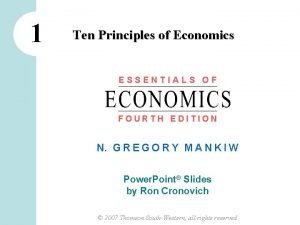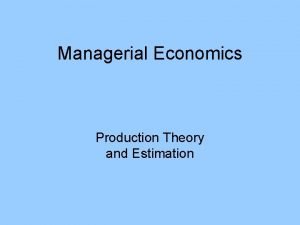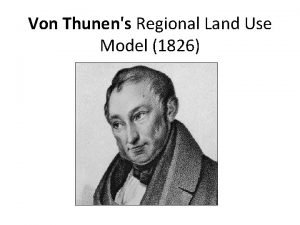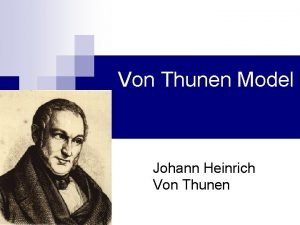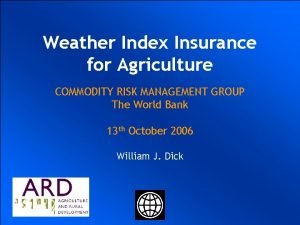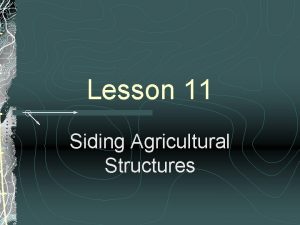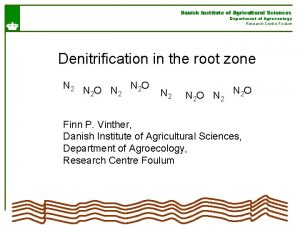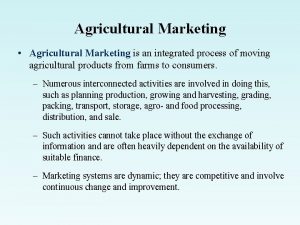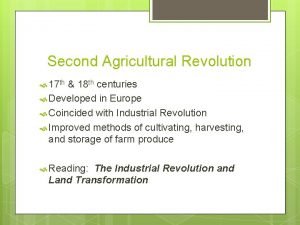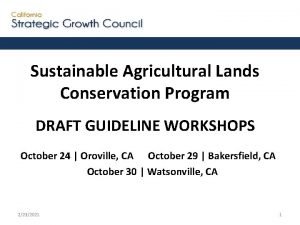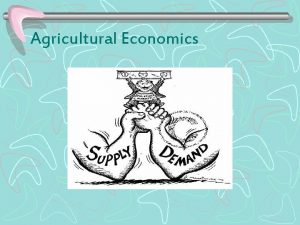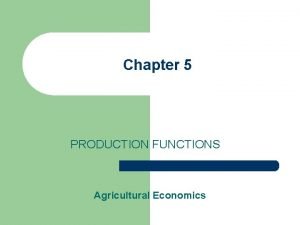Chapter 6 Agricultural Production Economics Production with One



















































































































- Slides: 115

Chapter 6: Agricultural Production Economics Production with One Input and One Output

A Production Function: Transformation of input into output A technical relationship (not behavioral)

Output: Corn Tobacco Wheat Beef Milk

Input: JOHN DEERE Seed Fertilizer Feed Machinery FERTILIZER 11 -48 -0 P 205 N K 20

Fixed versus Variable Inputs Fixed-Farmer does not expect to vary Over the planning horizon Variable-Farmer expects to vary Over the planning horizon ? ? ?

Length of Planning Horizon: in the mind of the farmer 6 months? The Growing Season? 2 years? 10 years (for Christmas trees)? Only the farmer knows for sure 6 months ? 2 years ? 50 years ?

Old idea-Inputs could be categorized Land--fixed Labor--variable Machinery--fixed (sort of!) JOHN DEERE Not a correct idea

Correct idea: Planning horizon determines whether inputs are fixed or variable Short Run--All inputs fixed Intermediate Run--Some fixed, some variable Long Run--All inputs variable

Inputs: Traditional list Land Labor Capital Management

With capital you can purchase land labor Is management an input? ?

A Production Function: Y = f(X) Y = output such as bu. of corn X = input such as fertilizer f(x) = rule for transforming X into Y such as: Y = 3 X 0. 5 Y=X 2 3 Y =. 3 X +. 05 X -. 002 X Each of these are production functions

Y = f(X 1 | X 2 X 3 X 4 ) The output The Variable input Inputs treated as fixed Y Y or TPP = Total Physical Product 3 X 1 | X 2 X 3 X 4

Y Y''' Y or TPP Y' X''' X'1 1 1 Specific amount of output from a specific amount of input X 1 | X 2 X 3 X 4

Marginal Product The incremental change in output associated with a 1 unit change in the use of the input

Marginal Product of input x: y = change in y x = change in x y = change in y = Marginal Product x = change in x Also called Marginal Physical Product or MPP for short

Diminishing, Constant and Increasing Marginal Product

Case 1: Constant Marginal Product

Constant Marginal Product Output (y) y Constant slope 8 6 4 2 0 1 2 3 4 Input (x)

Constant Marginal Product Output (y) y = 2 x Constant slope 8 6 2 Triangles all the same size and slope 1 4 2 1 unit across 2 units up 1 2 2 1 0 1 2 3 4 Input (x)

Constant Marginal Product Output (y) y = 2 x Constant slope 8 6 2 1 4 2 1 2 2 Each additional unit of X produces two additional units of Y 1 2 1 0 1 2 3 4 Input (x)

(y) Output y =bx Constant slope of b b b 1 Each additional unit of x produces b additional Units of y The Marginal Product of an additional unit of x is b 1 0 Input (x) 2 3 4 1 Constant Marginal Product of b

Constant Marginal Product MPP x y/ x x y y

Constant Marginal Product MPP y/ x x x y y 0 0 1 2 2 4 3 6 4 8 5 10

Constant Marginal Product MPP y/ x x x y y 0 0 1 1 2 3 4 5 1 1 4 6 8 1 10

Constant Marginal Product MPP Y/ x x x y y 0 0 2 1 1 2 2 1 2 3 4 5 1 1 1 4 6 2 2 8 2 10

Constant Marginal Product MPP Y/ x x x y y 0 0 2 2/1 1 1 2 2 1 2/1 2 3 4 5 1 1 1 4 6 2 2/1 8 10 MPP = 2 everywhere

Constant MPP y=b b = Marginal Product of an Additional Unit of x x y = bx y b x

Case 2: Increasing Marginal Product

Output (y) 11 Increasing marginal returns to the variable input 4. 5 6. 5 3 1. 5 3. 5 2 0. 7 1. 3 0. 7 0 1 2 3 4 5 Input (x) Increasing Marginal Product

Increasing Marginal Product x 0 x y 0 1 0. 7 2 2. 0 3 3. 5 4 6. 5 5 11. 0 y MPP Y/ x

Increasing Marginal Product x 0 1 x 1 1 2 3 y 0 0. 7 2. 0 1 3. 5 1 4 5 6. 5 1 11. 0 y MPP Y/ x

Increasing Marginal Product MPP increases as x increases x 0 1 x 1 1 2 3 y 0 0. 7 2. 0 1 5 . 7 1. 3 1. 5 3. 1 4 y 6. 5 1 11. 0 4. 5 MPP Y/ x

Increasing Marginal Product MPP increases as x increases x 0 1 x 1 1 2 3 y 0 0. 7 2. 0 1 5 . 7/1 1. 3/1 1. 5/1 3. 0/1 3. 5 1 4 y MPP Y/ x 6. 5 1 11. 0 4. 5/1

Case 3: Decreasing (Diminishing) Marginal Product

Decreasing (Diminishing) Marginal Product Output (y) y = f(x) 8. 8 8. 5 8 . 3. 5 1 7 1 1 1 2 5 1 5 Slope increases but at a decreasing rate Additional units of x produce less and less additional y 1 0 1 2 3 4 5 Input (x)

Decreasing Marginal Product x x y y MPP y/ x

Decreasing Marginal Product x x y 0 0 1 5 2 7 3 8 4 8. 5 5 8. 8 y MPP y/ x

Decreasing Marginal Product x 0 1 2 3 4 5 x 1 1 1 y 0 5 7 8 8. 5 8. 8 y MPP y/ x

Decreasing Marginal Product x 0 1 2 3 4 5 x 1 1 1 y 0 5 7 8 y 5 2 1 0. 5 8. 5 0. 3 8. 8 MPP y/ x

Decreasing Marginal Product As the use of x increases, MPP decreases MPP x 0 1 2 3 4 5 x 1 1 1 y 0 5 7 8 y y/ 5 5/1 2 2/1 1 1/1 0. 5 . 5/1 8. 5 0. 3 8. 8 . 3/1 x

A Neoclassical Production Function X 1 | X 2 X 3 X 4 X 5

A Neoclassical Production Function Y X 1 | X 2 X 3 X 4 X 5

A Neoclassical Production Function Y Increasing MPP (and TPP) X 1 | X 2 X 3 X 4 X 5

A Neoclassical Production Function Y Increasing MPP (and TPP) Inflection Point X 1 | X 2 X 3 X 4 X 5

A Neoclassical Production Function Y Decreasing MPP Increasing TPP Increasing MPP (and TPP) Inflection Point X 1 | X 2 X 3 X 4 X 5

A Neoclassical Production Function Maximum TPP Y 0 MPP Decreasing MPP Increasing TPP Increasing MPP (and TPP) Inflection Point X 1 | X 2 X 3 X 4 X 5

A Neoclassical Production Function Maximum TPP Y 0 MPP Negative MPP Declining TPP Decreasing MPP Increasing TPP Increasing MPP (and TPP) Inflection Point X 1 | X 2 X 3 X 4 X 5

Law of Diminishing (Marginal) Returns As units of the variable input (X 1 ) are added to units of the fixed inputs ( X 2 , X 3 , X 4 , X 5 ) we eventually reach a point where each ADDITIONAL unit of the variable input (X 1 ) produces Less and Less ADDITIONAL output!

Y Decreasing MPP Increasing TPP Increasing MPP (and TPP) Maximum TPP 0 MPP Negative MPP Declining TPP Inflection Point Law of Diminishing Returns holds Starting Here X 1 | X 2 X 3 X 4 X 5

Maximum TPP 0 MPP Y Decreasing MPP Increasing TPP Increasing MPP Negative MPP Declining TPP Inflection Point (and TPP) X 1 | X 2 X 3 X 4 X 5

Maximum TPP 0 MPP Y Decreasing MPP Increasing TPP Increasing MPP Negative MPP Declining TPP Inflection Point (and TPP) MPP 0 X 1 | X 2 X 3 X 4 X 5

Maximum TPP 0 MPP Y Decreasing MPP Increasing TPP Increasing MPP Negative MPP Declining TPP Inflection Point (and TPP) MPP 0 X 1 | X 2 X 3 X 4 X 5 X 1 | X 2 X 3 X 4 X 5 MPP

Maximum TPP 0 MPP Y Decreasing MPP Increasing TPP Increasing MPP Negative MPP Declining TPP Inflection Point (and TPP) MPP 0 X 1 | X 2 X 3 X 4 X 5 X 1 | X 2 X 3 X 4 X 5 MPP

Maximum TPP 0 MPP Y Decreasing MPP Increasing TPP Increasing MPP Negative MPP Declining TPP Inflection Point (and TPP) MPP 0 X 1 | X 2 X 3 X 4 X 5 X 1 | X 2 X 3 X 4 X 5 MPP

Average Physical Product The ratio of output to variable input Y/X 1 | X 2 X 3 X 4 X 5 Average product of ALL units of X used (not the incremental unit)

TPP and APP Input Output (TPP) X 0 1 2 3 4 5 6 Y 0 7 16 21 24 25 18 APP Y/X undefined 7 8 7 6 5 3

Y TPP Inflection Point APP X

Line out of Origin Y TPP Inflection Point APP X

Line out of Origin Y Point of Tangency TPP Inflection Point APP X

Line out of Origin Y Point of Tangency TPP Inflection Point Maximum APP X

Line out of Origin Y Point of Tangency TPP Inflection Point Maximum APP X

Line out of Origin Y Ratio Y/X = Slope of Line From Origin TPP Y APP = Y/X X APP X

Y APP MAXIMUM APP: Never Negative Inflection Point X APP, MPP 0 APP X

Y APP MAXIMUM MPP=APP Inflection Point APP, MPP 0 MPP MAXIMUM MPP = APP X APP MPP = 0 X MPP

Marginal Physical Product Average Physical Product MPP APP X X MPP Do They have a Relationship? ? ?

MPP, APP 0 X 1 | X 2 X 3 X 4 X 5

MPP, APP Positive and Increasng APP 0 APP X 1 | X 2 X 3 X 4 X 5

MPP, Maximum APP Positive and Increasng APP 0 APP X 1 | X 2 X 3 X 4 X 5

MPP, APP Maximum APP Positive and Increasng APP 0 Positive but Decreasing APP X 1 | X 2 X 3 X 4 X 5

MPP, APP Maximum APP Positive and Increasng APP 0 Positive but Decreasing APP X 1 | X 2 X 3 X 4 X 5

Inflection Point of TPP Maximum MPP, APP Maximum APP Positive and Increasng APP 0 Positive but Decreasing APP X 1 | X 2 X 3 X 4 X 5

Inflection Point of TPP Maximum MPP, APP Increasing MPP Maximum APP Positive MPP=APP Positive and Increasng APP 0 Positive but Decreasing MPP 0 MPP Decreasing APP Maximum TPP X 1 | X 2 X 3 X 4 X 5

Inflection Point of TPP Maximum MPP, APP Increasing MPP Maximum APP Positive MPP=APP Positive and Increasng APP 0 Positive but Decreasing MPP 0 MPP Decreasing APP Maximum TPP X 1 | X 2 X 3 X 4 X 5 Negative and Decreasing MPP

Elasticity of Production measures: responsiveness of output to changes in the use of Inputs A pure number (has no units)

Elasticity of Production = % Change in output (Y) divided by % Change in input (X) % % in output Y in input X

Elasticity of Production % % = in output Y in input X Y/Y X/X X = MPP/APP. Y = X Y MPP 1/APP

% % in output Y in input X = MPP/APP The Elasticity of Production (Ep) is the Ratio of MPP to APP

Ep > 1 0<Ep<1 Ep < 0 (MPP>APP) Ep = 1 $ Increasing MPP Decreasing MPP Positive and Increasng APP 0 0 MPP Ep = 0 Maximum TPP AVP X 1 | X 2 X 3 X 4 X 5 Negative and Decreasing MPP MVP

When the elasticity of production is greater than one, MPP lies above APP, APP is increasing, but MPP may be either increasing or decreasing. When the elasticity of production is between zero and 1, both MPP and APP are decreasing. However, MPP is positive here. Wnen the elasticity of production is negative, MPP is negative, and TPP is falling. However, APP still remains positive.

Profit Maximixation: 1 input (X) and 1 output (Y)

Assumptions: 1. Constant Input Price The producer can purchase as much or as little of the needed input at the going market price. No producer can affect input prices by the amount of the purchase.

2. Constant Output Price No producer can affect the price of the output (Y) because of the individual production decision. The price of the input is V. The price of the output is P.

3. Production Function Known with Certainty This is an unrealistic assumption for agriculture!

Profit = Total Revenue - Total Cost = TR - TC. –V. X = PY so but Y = f(X) . = Pf(X) – V. X Total Value of Product Total Factor Cost

Maximizing Profit: Maximize the difference between TVP and TFC. . P f(X) - V X Total Value of Product Total Factor Cost TVP TFC

What is the appearance of a TVP CURVE?

The TVP curve is a production function with the vertical axis measured in dollar value of output, not physical units such as bushels or pounds. TVP = P. TPP

Production Function TVP Curve TPP. P TPP Y $ TPP X TPP. P =TVP X

What is the appearance of a Total Factor Cost (TFC) Curve?

Total Factor Cost (TFC) Curve $ TFC = V X. V 1 x

Now Superimpose TVP Curve $ TPP and TVP max TFC TVP TFC = V X. V 1 x

$ Tangent TPP and TVP max TFC TVP TFC = V X. V 1 Tangent x

$ TPP and TVP max Tangent TFC Left of TPP Max Right of APP max APP Max TVP TFC = V X. V 1 Tangent x

$ Tangent TPP and TVP max TFC TVP TFC = V X. Maximum Vertical Distance = Maximum Profit V 1 Maximum Vertical Distance = Maximum Loss Tangent x

$ Tangent TPP max TFC TVP TFC = V X. V 1 Tangent Profit is maximum where slope of TVP = Slope of TFC X

Slope of TVP = Slope of TPP P . = MPP. P = MVP = Marginal Value of the Product So profits are maximum where: Slope of TVP = Slope of TFC MVP = MFC MVP = V MVP = the input price, assuming constant input and output prices

$ Tangent TPP max TFC TVP TFC = V X. V 1 Tangent X $ MVP Profit Min AVP Max MVP=MFC=V MFC = V Profit Max MVP=MFC=V 0 X AVP=APP P MVP= MPP P

Stages of Production

Stage I 0 units of X to level of X which Maximizes AVP

Stage II Level of X that Maximizes AVP to Level of X that Maximizes TPP (0 MVP and 0 MPP)

Stage III Level of X that Maximizes TPP (0 MPP) Y Stage III X and Beyond. . .

The Rational Producer. . . 1. Never produces beyond the point of maximum TPP (input prices are never negative) 2. Produces at the point of maximum TPP only if the input is free! 3. Does not normally produce in stage I of Production Stage II is the Rational Stage of Production Where the profit maximizing point is found

Why not stage I? $ AVP=APP. P 0 Draw an AVP curve. Pick any point on the AVP curve. Average Value of the Product = Average Physical Product times the product price X

$ AVP 0 AVP=APP. P Area enclosed by rectangle is total revenue from the use of X' units of X X' X

$ AVP=APP. P 0 Now add MVP curve Marginal Value Product = Marginal Physical Product times the product price X MVP = MPP. P

$ AVP=APP P MFC=V 0 Total Factor Cost of Input X at profit max Maximum Profit X Now add MFC curve (MFC = V) Marginal Factor Cost = the price (V) of the input (X) MVP

$ AVP=APP. P MFC=V Total Revenue from sale of the product using profit maximizing level of X Maximum Profit 0 X MVP

$ AVP=APP. P Revenue-Cost=Profit 0 Total Factor Cost of Input X at Profit Max Cost of X MFC=V Maximum Profit X MVP

$ MFC= V Revenue AVP 0 X But if MFC > Maximum AVP Costs > Revenue MVP Lose money where MVP=MFC, and shut down instead!

$ MFC= V Revenue Cost of X AVP 0 X MVP

$ Loss Revenue MFC= V AVP 0 X Revenue fails to cover costs resulting in a loss as indicated MVP

Stages of Production and Elasticities of Production Stage I Ep > 1 Stage II 0 <Ep < 1 Stage III Ep < 0 Rational Stage where 0 <Ep < 1

Ep > 1 0<Ep<1 Ep < 0 (MPP>APP) Ep = 1 $ Increasing MPP Decreasing MPP Positive and Increasng APP 0 MPP 0 Ep = 0 Maximum TPP AVP X 1 | X 2 X 3 X 4 X 5 Negative and Decreasing MPP MVP Stage III

Ep > 1 0<Ep<1 Ep < 0 (MPP>APP) Ep = 1 $ Demand Curve for input X AVP 0 Ep = 0 X 1 | X 2 X 3 X 4 X 5 MVP Stage III

The Demand Curve for a Singe Input All Points of Intersection Between MFC and MVP that lie in Stage II of Production The Quantity of Input the Producer Would Use to Maximize Profits at Each Possible Input Price
 Branches of agricultural economics
Branches of agricultural economics Office of agricultural economics thailand
Office of agricultural economics thailand Proses post production
Proses post production Characteristics of agricultural production
Characteristics of agricultural production Ten principles of economics chapter 1
Ten principles of economics chapter 1 One of the ten principles of economics in chapter 1
One of the ten principles of economics in chapter 1 Economics and business economics maastricht
Economics and business economics maastricht What is mathematical economics
What is mathematical economics One god one empire one emperor
One god one empire one emperor One one one little dogs run
One one one little dogs run One king one law one faith
One king one law one faith Byzantine definition
Byzantine definition One ford
One ford See one do one teach one
See one do one teach one One price policy
One price policy Night structure
Night structure See one do one teach one
See one do one teach one One vision one identity one community
One vision one identity one community Asean one vision one identity one community
Asean one vision one identity one community Chapter 9 agricultural transformation and rural development
Chapter 9 agricultural transformation and rural development Chapter 9 agricultural transformation and rural development
Chapter 9 agricultural transformation and rural development The rise of civilization lesson 2 the neolithic revolution
The rise of civilization lesson 2 the neolithic revolution Early humans and the agricultural revolution
Early humans and the agricultural revolution Chapter 26 the great west and the agricultural revolution
Chapter 26 the great west and the agricultural revolution Production theory and estimation
Production theory and estimation The agricultural revolution
The agricultural revolution Von thunen model frq
Von thunen model frq Johann heinrich von thünen model
Johann heinrich von thünen model Paris basin map
Paris basin map Chester agricultural center
Chester agricultural center Nrrl culture collection
Nrrl culture collection Ffa to practice brotherhood
Ffa to practice brotherhood Qingdao agricultural university
Qingdao agricultural university Hearths of agriculture
Hearths of agriculture Which is the component of agriculture renewable action plan
Which is the component of agriculture renewable action plan Ffa brotherhood pledge
Ffa brotherhood pledge Agricultural revolution inventions
Agricultural revolution inventions First agricultural revolution
First agricultural revolution Agricultural accounting and finance kansas
Agricultural accounting and finance kansas Blue yonder lde
Blue yonder lde E learning portal on agricultural education
E learning portal on agricultural education Nepalese agricultural professionals of america
Nepalese agricultural professionals of america Egypt physiological density
Egypt physiological density Agricultural robot ppt
Agricultural robot ppt Von thunen theory of agricultural location
Von thunen theory of agricultural location Green revolution ap human geography
Green revolution ap human geography Third agricultural revolution
Third agricultural revolution Whittlesey agricultural regions
Whittlesey agricultural regions Von thunen's agricultural land use model
Von thunen's agricultural land use model Planned agricultural communities
Planned agricultural communities Agricultural weather index
Agricultural weather index Campus agricultural center
Campus agricultural center Ffa 3 ring model
Ffa 3 ring model Swot analysis for agricultural business
Swot analysis for agricultural business Swot analysis for agricultural business
Swot analysis for agricultural business National development plan
National development plan Using personal safety in agricultural mechanics
Using personal safety in agricultural mechanics Siding channel types
Siding channel types Agricultural contractor job tracker
Agricultural contractor job tracker Ruang lingkup geografi
Ruang lingkup geografi Derwent whittlesey agricultural regions
Derwent whittlesey agricultural regions Danish institute of agricultural sciences
Danish institute of agricultural sciences The map of agricultural hearths in your book indicates that
The map of agricultural hearths in your book indicates that Agricultural diffusion definition
Agricultural diffusion definition Marketing of agricultural products
Marketing of agricultural products Agricultural hearths
Agricultural hearths What is agricultural development
What is agricultural development What is agricultural development
What is agricultural development Agriculture quality management
Agriculture quality management Agricultural wastewater treatment technologies
Agricultural wastewater treatment technologies Von thunen agricultural model
Von thunen agricultural model Delta tau alpha agricultural honor society
Delta tau alpha agricultural honor society Monterey county agricultural commissioner
Monterey county agricultural commissioner Atmis.kilimo.go
Atmis.kilimo.go Kentucky agricultural development fund
Kentucky agricultural development fund Agricultural wastewater treatment technologies
Agricultural wastewater treatment technologies Agricultural confined space training
Agricultural confined space training Causes and effects of neolithic revolution
Causes and effects of neolithic revolution Agricultural revolution worksheet
Agricultural revolution worksheet 5 stages of agricultural development
5 stages of agricultural development What is agricultural marketing circle?
What is agricultural marketing circle? Agricultural careers list
Agricultural careers list Agricultural produce accounting
Agricultural produce accounting What is an sae
What is an sae Ffa ear of corn
Ffa ear of corn Biofeed fertilizer
Biofeed fertilizer Supervised agricultural experience definition
Supervised agricultural experience definition National agricultural innovation project
National agricultural innovation project Mayan agriculture techniques
Mayan agriculture techniques Agriculture in sangam period was developed in …
Agriculture in sangam period was developed in … Disruptive technology in agriculture
Disruptive technology in agriculture Ctpat
Ctpat Early humans and the agricultural revolution answer key
Early humans and the agricultural revolution answer key Branches of applied microbiology
Branches of applied microbiology Agricultural mechanics definition
Agricultural mechanics definition Calvin miller coltivare
Calvin miller coltivare Adding value to agricultural products
Adding value to agricultural products Pixabay
Pixabay Whittlesey agricultural classification
Whittlesey agricultural classification What crop started the third agricultural revolution
What crop started the third agricultural revolution The second agricultural revolution coincided with
The second agricultural revolution coincided with Samarkand agricultural institute
Samarkand agricultural institute Pakistan agriculture coalition
Pakistan agriculture coalition Important agricultural lands hawaii
Important agricultural lands hawaii Gramin agricultural markets
Gramin agricultural markets Six assumptions of von thunen model
Six assumptions of von thunen model The great west and the agricultural revolution
The great west and the agricultural revolution Sustainable agricultural lands conservation program
Sustainable agricultural lands conservation program Cooperative agricultural pest survey
Cooperative agricultural pest survey Ohio agricultural research and development center
Ohio agricultural research and development center National institute of agricultural technology
National institute of agricultural technology National institute of agricultural botany
National institute of agricultural botany Jf agricultural engineering
Jf agricultural engineering Agricultural credit policy council
Agricultural credit policy council Scope of agricultural marketing
Scope of agricultural marketing Bihar veterinary university
Bihar veterinary university





